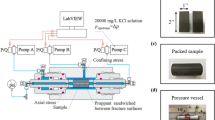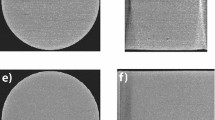Abstract
This paper compares the evolution of permeability with effective stress in propped fractures in shale for native CH4 compared with that for sorbing CO2, slightly sorbing N2 and non-sorbing He. We examine the response for laboratory experiments on artificial propped fractures in Green River Shale to explore mechanisms of proppant embedment and fracture diagenesis. Split cylindrical specimens sandwich a proppant bead-pack at a constant confining stress of 20 MPa and with varied pore pressure. Permeability and sorption characteristics are measured with the pulse transient method. To explore the effect of swelling and embedment on fracture surface geometry, we measure the evolution of conductivity characteristics for different proppant geometries (single layer vs. multilayer), gas saturation and specimen variation in order to simulate both production and enhanced gas recovery. The resulting morphology of embedment is measured by white light interferometry and characterized via surface roughness parameter of mean, maximum and root-mean-square amplitudes. For both strongly (CO2, CH4) and slightly adsorptive gases (N2), the permeability first decreases with an increase in gas pressure due to swelling before effective stress effects dominate above the Langmuir pressure threshold. CO2 with its highest adsorption affinity produces the lowest permeability among these three gas permeants. Monolayer propped specimens show maximum swelling and lowered k/k 0 ratio and increased embedment recorded in the surface roughness relative to the multilayered specimens. Permeabilities measured for both injection and depletion cycles generally overlap and are repeatable with little hysteresis. This suggests the dominant role of reversible swelling over irreversible embedment. Gas permeant composition and related swelling have an important effect on the permeability evolution of shales.

















Similar content being viewed by others
References
Alramahi B, Sundberg MI (2012) Proppant embedment and conductivity of hydraulic fractures in shales. American Rock Mechanics Association, Chicago
Andrews T (1869) On the continuity of the gaseous and liquid states of matter. Philos Trans 159:575–590
Bai M, Elsworth D (1994) Modeling of subsidence and stress-dependent hydraulic conductivity for intact and fractured porous media. Rock Mech Rock Eng 27:209–234
Berryman JG (1981) Elastic wave propagation in fluid-saturated porous media. J Acoust Soc Am 69:416–424
Brace WF, Walsh JB, Frangos WT (1968) Permeability of granite under high pressure. J Geophys Res 73(6):2225–2236
Carman PC (1937) Fluid flow through granular beds. Trans Inst Chem Eng Lond 15:150–166
Chandra C (2012) Mechanical and transport characteristics of coal-biomass mixtures for advanced IGCC systems. PennState MS Thesis
Chen T, Feng X, Pan Z (2015) Experimental study of swelling of organic rich shale in methane. Int J Coal Geol 150–151(1):64–73
Cooke CE (1977) Hydraulic fracturing with a high-strength proppant. J Petrol Technol 29:1222–1226
Elsworth D, Yasuhara H (2010) Mechanical and transport constitutive models for fractures subject to dissolution and precipitation. Int J Numer Anal Methods Geomech 34:533–549
Freeman ER, Anschutz DA, Rickards AR, Callanan MJ (2009) Modified API/ISO crush tests with a liquid-saturated proppant under pressure incorporating temperature, time, and cyclic loading: What does it tell us?. SPE Hydraulic Fracturing Technology Conference Society of Petroleum Engineers, The Woodlands
Haro C (2013) The theory behind the Carman–Kozeny equation in the quest for permeability of the Rocks. In: GeoConvention: Integration, 5th–10th May, Calgary, Canada
Heller R, Zoback M (2014) Adsorption of methane and carbon dioxide on gas shale and pure mineral samples. J Unconv Oil Gas Resour 8:14–24
Hsieh PA et al (1981) A transient laboratory method for determining the hydraulic properties of ‘tight’ rocks—I. Theory. Int J Rock Mech Min Sci Geomech Abstr 18(3):245–252
Kozeny J (1927) Ueber kapillare Leitung des Wassers im Boden. Sitzungsber Akad Wiss 136(2a):271–306
Kumar H, Elsworth D, Mathews JP, Marone C (2016) Permeability evolution in sorbing media: analogies between organic-rich shale and coal. Geofluids 16(1):43–55
Lacy LL, Rickards AR, Ali SA (1997) Embedment and fracture conductivity in soft formations associated with HEC, borate and water-based fracture designs. SPE Annual Technical Conference and Exhibition, San Antonio
Meyers RA (1982) The macromolecular structure of coal: coal structure. Academic Press Inc., New York, p 250
Pellenq RJ, Brochard L, Damme MV, Ulm FJ (2012) From the fundamentals of porous carbons poromechanics to applications for CO2 sequestration and gas-shale. Pittsburgh, AIChE
Piggott AR, Elsworth D (1993) Laboratory assessment of the equivalent apertures of a rock fracture. Geophys Res Lett 20:1387–1390
Rose HE (1945) An investigation into the laws of flow of fluids through granular material. Proc Inst Mech Eng 153:141–148
Shimada S, Li H, Oshima Y, Adachi K (2005) Displacement behavior of CH4 adsorbed on coals by injecting pure CO2, N2, and CO2–N2 mixture. Environ Geol 49:44–52
Siriwardane H et al (2009) Influence of carbon dioxide on coal permeability determined by pressure transient methods. Int J Coal Geol 77:109–118
Slichter CS (1899) Theoretical investigation of the motion of ground water. US Geol. Survey 19th Ann. Rept., Vol pt. 2, pp 295–384
Somerton WH, Soylemezoglu IM, Dudley RC (1975) Effect of stress on permeability of coal. Int J Rock Mech Min Sci Geomech Abstr 12:129–145
Stoddard T, McLennan T, Moore J (2011) Fracture conductivity of a bauxite-propped geothermal system at in situ conditions. In: Thirty-Sixth Workshop on Geothermal Reservoir Engineering, Stanford University, Stanford
Walsh JB (1981) Effect of pore pressure and confining pressure on fracture permeability. Int J Rock Mech Min Sci Geomech Abstr 18:429–435
Wang S, Elsworth D, Liu J (2011) Permeability evolution in fractured coal: the roles of fracture geometry and water-content. Int J Coal Geol 87:13–25
Yasuhara H, Elsworth D (2008) Compaction of a rock fracture moderated by competing roles of stress corrosion and pressure solution. Appl Geophys 165:1289–1306
Yasuhara H et al (2006) Evolution of fracture permeability through fluid–rock reaction under hydrothermal conditions. Earth Planet Sci Lett 244:186–200
Acknowledgements
This work was supported by Aramco Services Company. This support is gratefully acknowledged. We also thank Takuya Ishibashi for his assistance with fracture surface roughness measurement.
Author information
Authors and Affiliations
Corresponding author
Rights and permissions
About this article
Cite this article
Li, X., Feng, Z., Han, G. et al. Permeability Evolution of Propped Artificial Fractures in Green River Shale. Rock Mech Rock Eng 50, 1473–1485 (2017). https://doi.org/10.1007/s00603-017-1186-2
Received:
Accepted:
Published:
Issue Date:
DOI: https://doi.org/10.1007/s00603-017-1186-2




